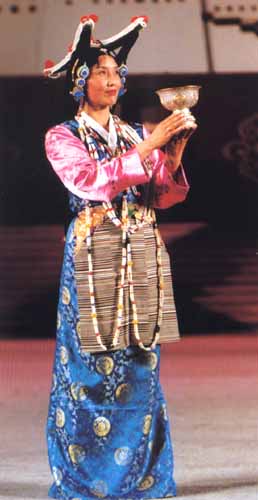
Before the democratic reform in Tibet in 1959, the feudal serfdom imposed a rigorous hierarchy on the Tibetan society, which also found expression in costume and ornaments. At that time, the ordinary people could not protect themselves from the cold, let alone enjoy the costume culture.
After the democratic reform, serfs of the past became the masters of Tibet. Their enhanced political status has enabled them to enjoy richer material and cultural life. Especially after the 1980s when China began to implement the open and reform policies, the Tibetan people, like the people in the interior, experienced great changes in their life. Many luxurious robes and precious jewelry that were once exclusively for the aristocrats are now common among the ordinary people.
With the elapse of times, Tibetan costume and ornaments have been changing constantly. In recent years, the people of Tibet have also devoted efforts to bring forth new ideas concerning the reform of traditional costume and ornaments. In Lhasa, Xigaze and other places, people have set up research institutes for national culture and art, opened national garment factories and sales shops and established societies for national handiwork. All this has given an
impetus to popularizing and creating new fashions of Tibetan costume.
The present trend in Tibetan costume reform is mainly manifested in the taking-in of the loose waist of the robes, especially robes for women. The smaller measurement of the waist of the robes for women reveal the curve and grace of the female body. In terms of color, related colors have been used to replace colors of sharp contrast to create unity and harmony.
For example, costume with a red keynote is matched with bright red, slightly bright rd and brownish red patterns and ornaments, and some color stripes or patches of green or blue so that the effect will be uniform and variable, quiet and attractive.
Tibetan costume shows have been organized by relevant departments to make it widely known and enjoyed. Young men and women are coming from Lhasa to Beijing and places outside China in newly designed Tibetan costume, which have been widely acclaimed by fashion designers home and abroad.
